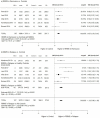Cerebrospinal fluid neurofilament light chain in multiple sclerosis and its subtypes: a meta-analysis of case-control studies
- PMID: 31123141
- PMCID: PMC6820150
- DOI: 10.1136/jnnp-2018-319190
Cerebrospinal fluid neurofilament light chain in multiple sclerosis and its subtypes: a meta-analysis of case-control studies
Abstract
Objective: Neurofilament is a biomarker of axonal injury proposed as a useful adjunct in the monitoring of patients with multiple sclerosis (MS). We conducted a systematic review and meta-analysis of case-control studies that have measured neurofilament light chain (NfL) levels in cerebrospinal fluid (CSF) of people with MS (pwMS), in order to determine whether, and to what degree, CSF NfL levels differentiate MS from controls, or the subtypes or stages of MS from each other.
Methods: Guidelines on Preferred Reporting Items for Systematic Reviews and Meta-Analyses were followed. Electronic databases were searched for published and 'grey' literature, with 151 hits. Of 51 full articles screened, 20 were included in qualitative analysis, and 14 in meta-analysis.
Results: CSF NfL was higher in 746 pwMS than 435 (healthy and disease) controls, with a moderate effect size of 0.61 (p < 0.00001). Mean CSF NfL levels were significantly higher in 176 pwMS with relapsing disease than 92 with progressive disease (2124.8 ng/L, SD 3348.9 vs 1121.4 ng/L, SD 947.7, p = 0.0108). CSF NfL in 138 pwMS in relapse (irrespective of MS subtype) was double that seen in 268 pwMS in remission (3080.6 ng/L, SD 4715.9 vs 1541.7 ng/L, SD 2406.5, p < 0.0001).
Conclusions: CSF NfL correlates with MS activity throughout the course of MS, reflecting the axonal damage in pwMS. Relapse is more strongly associated with elevated CSF NfL levels than the development of progression, and NfL may be most useful as a marker of disease 'activity' rather than as a marker of disability or disease stage.
Keywords: CSF; multiple sclerosis; neuroimmunology.
© Author(s) (or their employer(s)) 2019. Re-use permitted under CC BY. Published by BMJ.
Conflict of interest statement
Competing interests: None declared.
Figures






Similar articles
-
Neurofilament heavy chain in CSF correlates with relapses and disability in multiple sclerosis.Neurology. 2011 Apr 5;76(14):1206-13. doi: 10.1212/WNL.0b013e31821432ff. Epub 2011 Feb 23. Neurology. 2011. PMID: 21346223
-
Prognostic value of cerebrospinal fluid neurofilament light chain and chitinase-3-like-1 in newly diagnosed patients with multiple sclerosis.Mult Scler. 2019 Oct;25(11):1444-1451. doi: 10.1177/1352458518794308. Epub 2018 Aug 16. Mult Scler. 2019. PMID: 30113249
-
Biomarkers of tau phosphorylation state are associated with the clinical course of multiple sclerosis.Mult Scler Relat Disord. 2024 Oct;90:105801. doi: 10.1016/j.msard.2024.105801. Epub 2024 Aug 5. Mult Scler Relat Disord. 2024. PMID: 39153429
-
Neurofilament light chain in blood as a diagnostic and predictive biomarker for multiple sclerosis: A systematic review and meta-analysis.PLoS One. 2022 Sep 14;17(9):e0274565. doi: 10.1371/journal.pone.0274565. eCollection 2022. PLoS One. 2022. PMID: 36103562 Free PMC article.
-
Neuronal and glial CSF biomarkers in multiple sclerosis: a systematic review and meta-analysis.Rev Neurosci. 2021 Feb 17;32(6):573-595. doi: 10.1515/revneuro-2020-0145. Print 2021 Aug 26. Rev Neurosci. 2021. PMID: 33594840
Cited by
-
Empathy and Theory of Mind in Multiple Sclerosis: A Meta-Analysis.Front Psychiatry. 2021 Apr 9;12:628110. doi: 10.3389/fpsyt.2021.628110. eCollection 2021. Front Psychiatry. 2021. PMID: 33897490 Free PMC article.
-
Validity of serum neurofilament light chain as a prognostic biomarker of disease activity in multiple sclerosis.J Neurol. 2023 Apr;270(4):1908-1930. doi: 10.1007/s00415-022-11507-y. Epub 2022 Dec 15. J Neurol. 2023. PMID: 36520240 Review.
-
Blood neurofilament light: a critical review of its application to neurologic disease.Ann Clin Transl Neurol. 2020 Dec;7(12):2508-2523. doi: 10.1002/acn3.51234. Epub 2020 Nov 4. Ann Clin Transl Neurol. 2020. PMID: 33146954 Free PMC article. Review.
-
Neurofilaments in progressive multiple sclerosis: a systematic review.J Neurol. 2021 Sep;268(9):3212-3222. doi: 10.1007/s00415-020-09917-x. Epub 2020 May 23. J Neurol. 2021. PMID: 32447549 Free PMC article.
-
Serum Vitamin D3 as a Potential Biomarker for Neuronal Damage in Smoldering Multiple Sclerosis.Int J Mol Sci. 2024 Sep 29;25(19):10502. doi: 10.3390/ijms251910502. Int J Mol Sci. 2024. PMID: 39408830 Free PMC article.
References
-
- Arrambide G, Rovira A, Sastre-Garriga J, et al. . Spinal cord lesions: a modest contributor to diagnosis in clinically isolated syndromes but a relevant prognostic factor. Mult Scler J [Internet] 2017;1352458517697830. - PubMed
Publication types
MeSH terms
Substances
Grants and funding
LinkOut - more resources
Full Text Sources
Other Literature Sources
Medical
Research Materials
Miscellaneous
